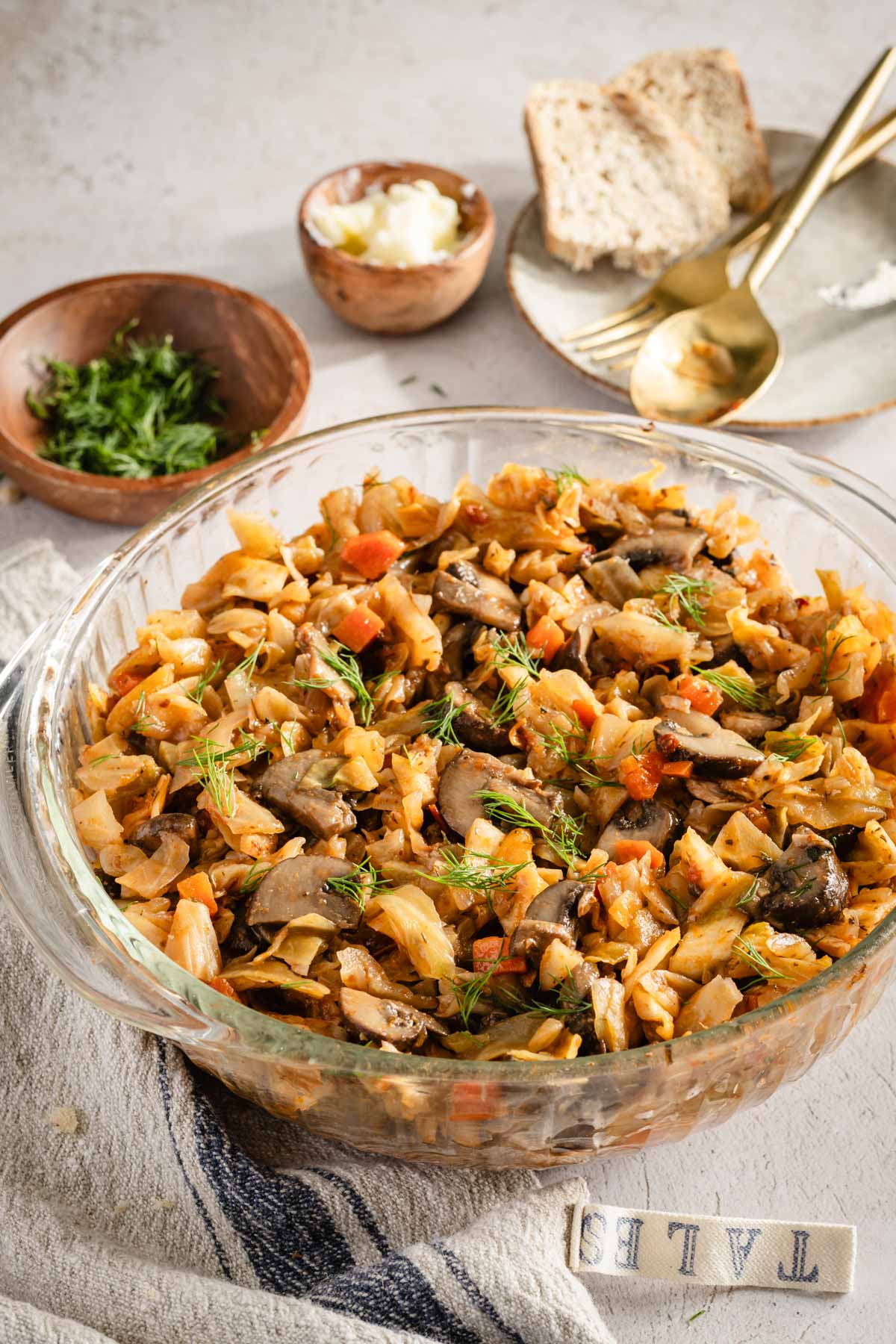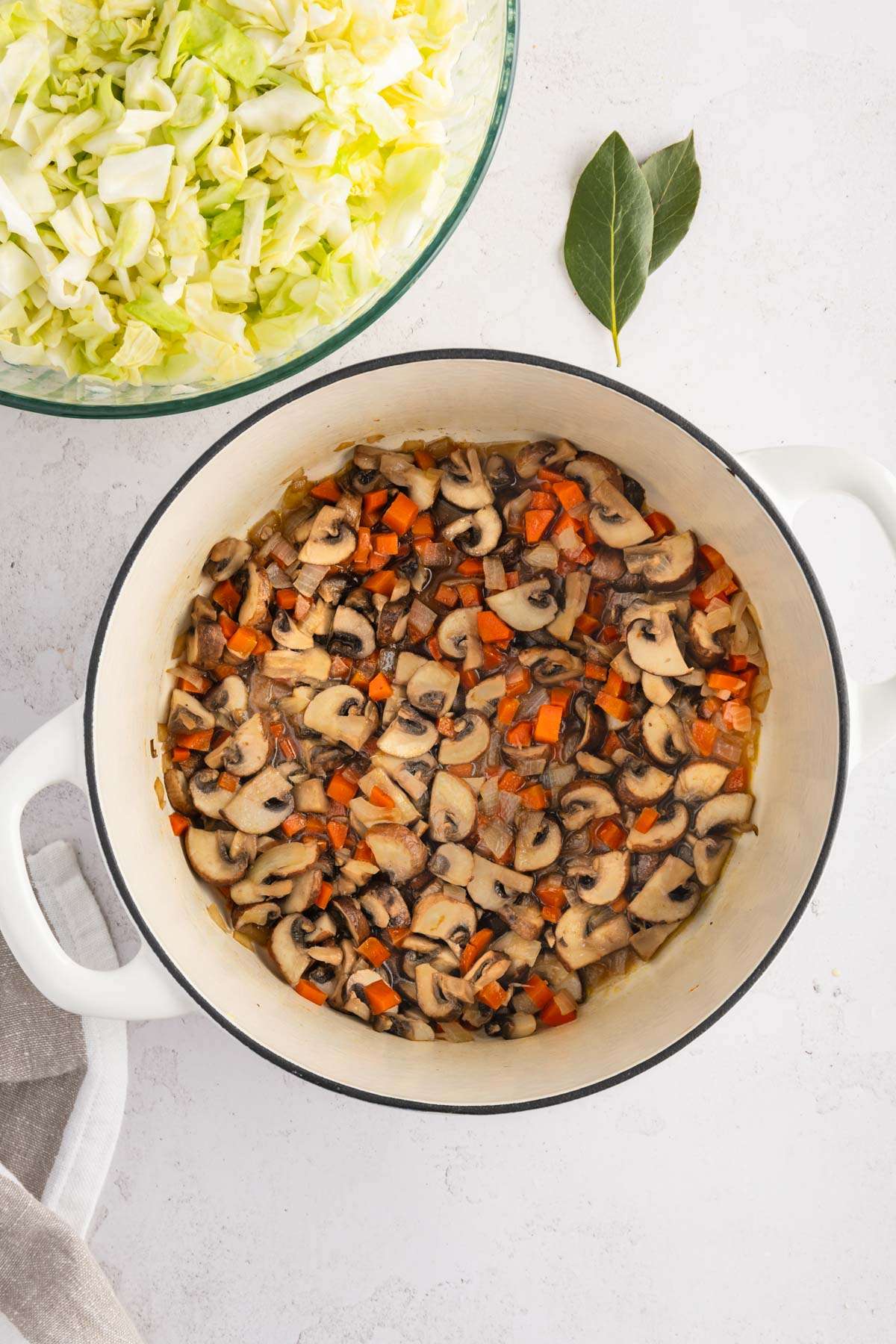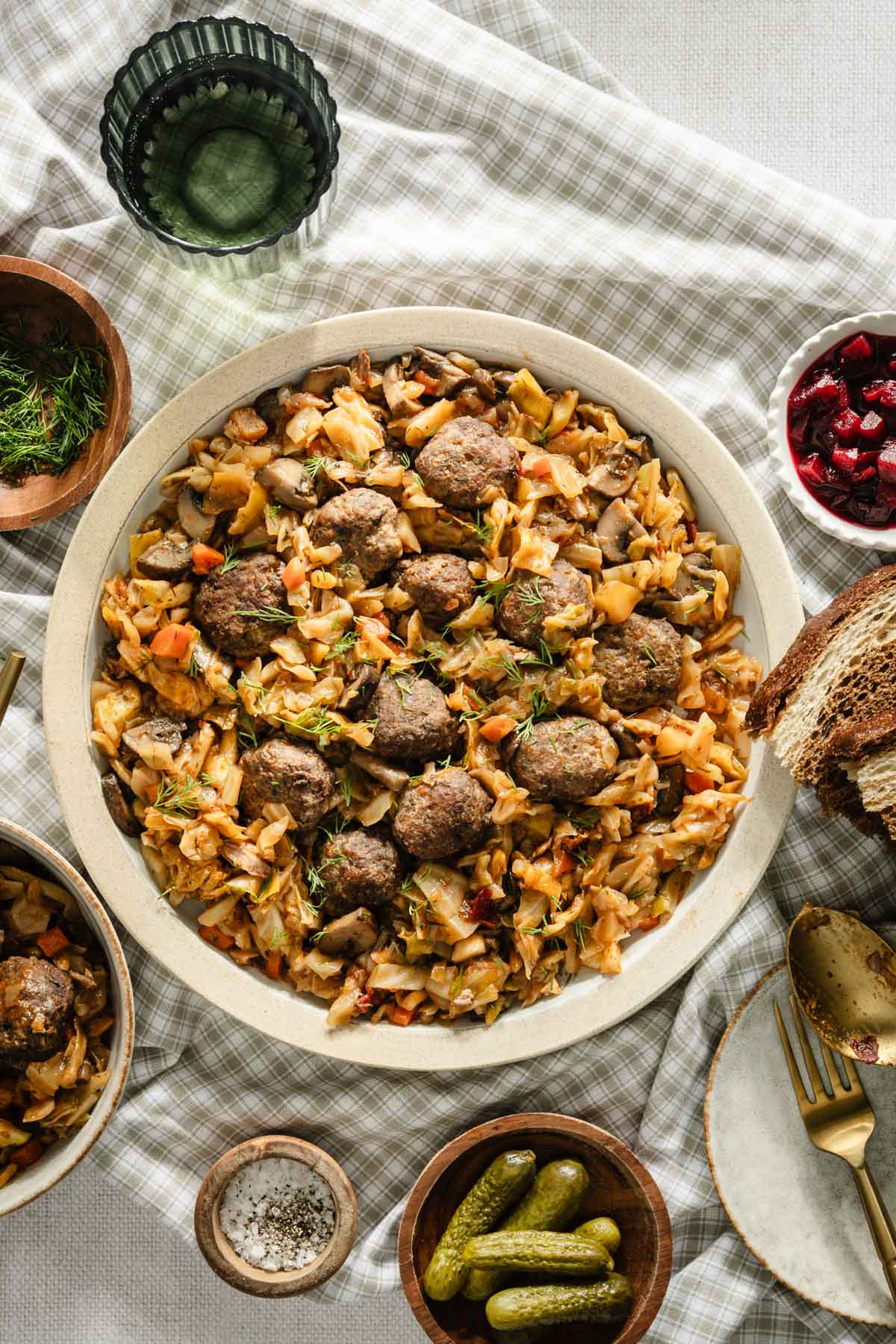Easy Smoked Cabbage Stew
This, easy, one pot Smoked Cabbage Stew is a great vessel to create a delicious meal in no time. Add smoked ribs, meatballs or homemade sausage or eat just as is. I guarantee you will be satisfied, full for hours, and love cabbage stew!

Making soup and stews on the smoker on a cold day is one of my favorite things to do. From Traditional Polish Borscht Soup, or Smoked Black Eyed Pea Stew to cabbage stew, there are so many options to create a delicious and nutritious dish that warms you up from the inside out.
This cabbage stew is no different – feed the crowd meal. This Smoked Cabbage Stew will get you brownie points at the potluck party. I guarantee it.
This easy to make dish is almost hands off. Need to stir it a few times during the cook so the flavors meld together and that is pretty much it.
Why you will love this dish?
- Easy and quick to make one pot dish
- Versatile, adapt to your dietary needs, vegetarian or vegan without losing flavor
- Need to feed a crowd, this is your dish
- Side dish or full meal, serve as is or add delicious protein like ribs or meatballs
- Add grains or potatoes for hearty variation
- Have extra veggies (expiring soon), add them to this cabbage stew
- Experiment with herbs and spices, make it to your liking
- Add more broth and make it into soup
- This stew tastes even better the next day, so don’t hesitate to make a big batch and enjoy the leftovers for days to come

Ingredients, Variations and Substitutions

Cabbage – chop it into uniform pieces to ensure even cooking. Adjust the amount based on personal preference for cabbage-to-other-ingredient ratio. Savoy cabbage or Napa cabbage can be used as alternatives, though they may have slightly different textures and flavors.
Salt – enhances the natural flavors of the ingredients and helps to balance the overall taste of the stew. Adjust the amount of salt based on personal preference. Keep in mind the sodium content of other ingredients, such as the broth and barbecue sauce. Sea salt or kosher salt can be used interchangeably with table salt.
Oil – used for sautéing the vegetables. Use a neutral-flavored oil with a high smoke point, such as vegetable oil or canola oil. Olive oil or avocado oil can be used as alternatives for a different flavor profile.
Onion – dice the onion finely for even distribution throughout the stew. Shallots or leeks can be used as substitutes for onions, offering similar flavor profiles.
Carrots – add a sweet note and vibrant color to the stew. Sweet potatoes or parsnips can be used as alternatives to carrots, providing similar sweetness and texture.



Broth – savory base for the stew. Use vegetable broth for a vegetarian option or chicken broth for a meatier flavor. Water can be used as a substitute, though the flavor may not be as robust.
Tomato puree – adds richness and tanginess to the stew. Use store-bought tomato puree or make your own by blending fresh tomatoes until smooth. Crushed tomatoes or tomato sauce can be used as alternatives.
Tomato paste – adds concentrated tomato flavor and thickness to the stew. A little goes a long way! Tomato sauce or ketchup can be used as alternatives for a similar tomato flavor.
BBQ sauce – adds a sweet and tangy flavor with a hint of smokiness to the stew. Choose your favorite BBQ sauce or make your own for a customized flavor profile. Ketchup mixed with a splash of Worcestershire sauce and a pinch of smoked paprika can be used as an alternative.
Chipotle in adobo – smoky and spicy kick to the stew, along with depth of flavor. Adjust the amount based on personal preference. Smoked paprika or hot sauce can be used as alternatives for a similar smoky flavor and heat.
Marjoram, thyme, dill – use fresh herbs for a vibrant flavor, or dried herbs for convenience. Oregano or parsley are great alternatives and provide a similar flavor profile.
Mushrooms – they add rich, earthy flavor and meaty texture to the stew. Any variety of mushrooms can be used, such as button mushrooms, cremini mushrooms, or shiitake mushrooms.
Bay leaves – add herbal note to the cabbage. Remember to remove them before serving. Fresh or dried thyme can be used as an alternative herb for added flavor.



Worcestershire sauce – adds umami flavor to the stew. Worcestershire sauce contains anchovies, so it may not be suitable for vegetarians. Look for vegetarian-friendly alternatives. Soy sauce or tamari can be used as alternatives.
Smoked or regular paprika – rich, smoky flavor and vibrant color to the stew. Use sweet or regular paprika for a milder option.
Salt and pepper – season the stew to taste, adjusting the amount of salt and pepper as needed.
Is cabbage healthy?
Cabbage is low in calories and high in fiber, making it a filling and nutritious addition to meals.
Versatile and easy to include in your diet cabbage can be enjoyed raw in salads, cooked in soups and stews, or fermented into sauerkraut or kimchi. It’s easy to incorporate cabbage into a variety of dishes for added flavor and nutrition.
Tips to remember when preparing cabbage:
Adding Baking Soda – Some cooks add a small amount of baking soda to the water when boiling cabbage. Baking soda helps to break down the cell walls of the cabbage more quickly, resulting in a softer texture and shorter cooking time. However, it can also cause the cabbage to lose some of its nutrients and flavor. Use baking soda sparingly, as too much can make the cabbage mushy.
Soaking Cabbage – Soaking cabbage in cold water for about 15-30 minutes, can help to crisp it up and remove any dirt or debris. This technique is recommended especially when making cabbage salads or slaws to ensure that the cabbage is crisp and clean. After soaking, be sure to rinse the cabbage thoroughly under cold water before using it in your recipe.
Adding Vinegar – Adding vinegar to cooked cabbage can add a tangy flavor and help to balance its natural sweetness. Vinegar is commonly used in recipes like braised cabbage or cabbage soup to enhance the overall flavor profile. It can also help to tenderize the cabbage slightly and prevent it from becoming too mushy during cooking. Experiment with different types of vinegar, such as apple cider vinegar, white vinegar, or balsamic vinegar, to find the flavor that you prefer.

Equipment you will need:
- Large Pot or Dutch Oven
- Cutting Board and chef’s Knife
- Wooden Spoon or Spatula
- Measuring Spoons and Cups:
- Can Opener
- Ladle
- Wood pellet smoker
Top tips for making Smoked Cabbage Stew
Choose Quality Ingredients – crisp cabbage and vibrant vegetables will enhance the overall taste and texture of your stew.
Balance Flavors – adjust the seasoning as needed to achieve the perfect balance of sweet, savory, smoky, and tangy flavors.
Layer Flavors – don’t skip sautéing aromatics like onion and garlic. This helps to develop a rich and complex flavor profile in the stew.
Control Spiciness – start with a small amount and adjust to taste, keeping in mind the preferences of you and your guests.
Low and Slow – allow the flavors to meld together and the vegetables to become tender. Stir occasionally to prevent sticking and ensure even cooking.
Check Consistency – if the stew is too thick, add more broth or water. If it’s too thin, you can simmer it uncovered for a bit longer to reduce and thicken the sauce.
Remove Bay Leaves – from the stew before serving. Bay leaves are added for flavor but are not meant to be eaten.
Garnish – the final touch before serving. Add fresh herbs, a dollop of sour cream, Greek yogurt, or a squeeze of lemon just before serving.
Make it the day before – for the best results, allow the stew to rest. This allows the flavors to develop and intensify, resulting in a more delicious and satisfying dish.
Step by step for making Smoked Cabbage Stew
- Wash and chop the cabbage into bite-sized pieces.
- Add salt to the chopped cabbage and massage it for a minute or so. This simple yet effective technique that can improve the texture, flavor, and overall quality of your dishes



- Dice the onion and carrots. Slice the mushrooms.
- Heat oil in a large pot or Dutch oven over medium heat. Add diced onion to the pot and sauté until softened and translucent. About 3-4 minutes



- Add carrots and cook together for a few minutes. Add mushrooms. Stir to combine and simmer for 5 or so minutes.
- Add cabbage. You can do it all at once or add it gradually, stirring well after each addition to combine and mix with other ingredients. Cook 5-6 minutes until the vegetables begin to soften



- Add the rest of the ingredients, broth, tomato puree and paste, bbq sauce, chipotle and all the seasonings. Stir well to combine all the ingredients and distribute them evenly throughout the stew.
- Preheat your smoker to 225-250F. Oak, maple, or fruitwoods such as cherry or apple wood pellets will complement the flavors of the cabbage stew.
- Transfer the pot with stew to the smoker. Leave the lid off the pot for the first 15-20 minutes of the cook. This will allow the cabbage stew to absorb and get infused with smoky flavor.
- After this initial smoke, place the lid on the pot and continue cooking, stirring occasionally. It may take another hour or so to cook
- The Cabbage Stew is done when the vegetables are tender. Taste for seasoning and adjust accordingly.
- Once the stew is cooked, remove it from the smoker, discard the bay leaves, set aside and let the flavors meld.
- Garnish with fresh herbs and serve hot with crusty bread, potatoes or meat of your choice.
Best ways to enjoy Smoked Cabbage Stew
- Serve with Crusty Bread
- Pair with Mashed Potatoes
- Serve with a side of smoked sausage
- Top with Sour Cream or Greek Yogurt
- Serve with Pickles or Fermented Vegetables
- Enjoy with a Side Salad
- Pair with Smoked Ribs or Meatballs: Easy Smoked Meatballs or BBQ Meatballs


You may also like:
Storage instructions, reheating
- Refrigeration:
- transfer to an airtight container once it has cooled to room temperature. Refrigerate promptly (within 2 hours of cooking) to prevent bacterial growth.
- Use within 3-4 days for optimal freshness.
- Freezing:
- Portion the Cabbage Stew into freezer-safe containers or resalable freezer safe bags (leave some space for expansion).
- use within 2-3 months for the best quality and taste.
- Reheating:
- From Refrigerator:
- Stovetop: Place desired amount of Cabbage Stew in a saucepan and reheat over low to medium heat. Stir occasionally to ensure even warming.
- Microwave: always use microwave -safe container; reheat in short intervals, stirring in between to distribute the heat
- From the Freezer:
- thaw the stew overnight in the refrigerator or you can also use the defrost setting on on your microwave. Once thawed, follow the same instructions as for refrigerated stew.
- From Refrigerator:
- Use food thermometer to check that the Cabbage Stew is thoroughly reheated. Minimum temperature should be 165°F (74°C) before serving.
- If the stew thickens upon reheating, you can add a splash of broth or water to adjust the consistency to your liking

Easy Smoked Cabbage Stew
Equipment
- large pot or Dutch oven
- cutting board
- chef's knife
- spoon or spatula
- vegetable peeler
- measuring cups and spoons
- wood pellet smoker
Ingredients
- 1 head of cabbage chopped
- 1 tsp salt
- 1 medium onion diced
- 2 carrots diced
- 2 cups sliced mushrooms
- 2 tbsp oil
- ½ cup tomato pure strained tomatoes
- ½ cup bbq sauce
- 1 cup broth
- 1 tbsp chipotle in adobo
- 1 tbsp Worcestershire sauce
- 1 tbsp tomato paste
- 2 bay leaves
- 1 tsp marjoram
- 1 tsp smoked paprika
- 1 tsp thyme
- 1 tsp dill
- Salt pepper
Instructions
- Wash and chop the cabbage into bite-sized pieces.
- Add salt to the chopped cabbage and massage it for a minute or so. This simple yet effective technique that can improve the texture, flavor, and overall quality of your dish.
- Peel and dice the onion and carrots. Clean and slice the mushrooms.
- Heat oil in a large pot or Dutch oven over medium heat. Add diced onion to the pot and saute until softened and translucent. About 3-4 minutes
- Add carrots and cook together for a few minutes. Add mushrooms. Stir to combine and simmer for 5 or so minutes.
- Add cabbage. You can do it all at once or add it gradually, stirring well after each addition to combine and mix with other ingredients. Cook 5-6 minutes until the vegetables begin to soften.
- Add the rest of the ingredients, broth, tomato puree and paste, bbq sauce, chipotle and all the seasonings. Stir well to combine all the ingredients and distribute them evenly throughout the stew.
- Preheat your smoker to 225-250F. Oak, maple, or fruitwoods such as cherry or apple wood pellets will complement the flavors of the cabbage stew.
- Transfer the pot with stew to the smoker. Leave the lid off the pot for the first 15-20 minutes of the cook. This will allow the cabbage stew to absorb and get infused with smoky flavor.
- After this initial smoke, place the lid on the pot and continue cooking, stirring occasionally. It may take around 2 hours more to cook.
- The Cabbage Stew is done when the vegetables are tender. Taste for seasoning and adjust accordingly.
- Once the stew is cooked, remove it from the smoker, discard the bay leaves, set aside and let the flavors meld.
- Garnish with fresh herbs and serve hot with crusty bread, potatoes or meat of your choice.
Notes
Nutrition
Did you make this recipe?
Tag me @sylwiavaclavekphotography or tag me using #myomnikitchen so I can see your creations! You can also leave a comment below!


Conclusion
Cabbage Stew cooked on the smoker may not be the traditional way, but it sure does turn out delicious. By infusing the stew with subtle smokiness, we elevate the humble cabbage to new heights.
Whether enjoyed on a chilly evening or as a centerpiece for gatherings with loved ones, this smoked cabbage stew will be the hero dish.
So fire up your smoker, embrace the art of slow cooking, and savor every spoonful of this hearty and flavorful Smoked Cabbage Stew for dinner tonight.
Here’s to good food, good company, and the simple joys of delicious food.
FAQ
Can I use different types of cabbage?
Yes, you can experiment with different varieties of cabbage, such as green cabbage, red cabbage, Savoy cabbage, or Napa cabbage, depending on your preference and availability.
Can I make this stew vegetarian or vegan?
Absolutely! You can use vegetable broth instead of meat-based broth. You can also add plant-based protein sources like kidney beans or tofu for added substance.
Can I make this stew heartier?
Yes, and it is so easy! Add delicious protein like sausage (smoked or chicken are my favorite), ribs, Easy Smoked Meatballs or Smoked Bacon. You can also include more shredded cabbage or other vegetables you have on hand. I recommend adding sausage and cabbage after you try the original recipe link above. I think you’ll be pleasantly surprised by how wholesome this stew is.
What is the difference between cabbage soup and stew?
Cabbage soup and stew are often used interchangeably, but they are different. Cabbage soup is a lighter, broth-based dish. Focused on cabbage and other vegetables, offering a clear and flavorful liquid. Cabbage stew is thicker than cabbage soup and often includes larger pieces of vegetables and frequently meat. It also may have a base enriched with starches or creams, making it heartier and more substantial.
How can I adjust the spiciness of the stew?
If you prefer a milder stew, you can reduce or omit the chipotle in adobo sauce and adjust the amount of paprika and other spices to taste. Conversely, if you enjoy more heat, you can increase the amount of chipotle or add additional spicy ingredients like cayenne pepper.
Can I make this Cabbage Stew ahead of time?
Yes, you can make the stew ahead of time and store it in the refrigerator for a few days or freeze it for longer storage. Simply reheat it gently on the stovetop or in the microwave before serving.
What can I serve with cabbage stew?
Cabbage stew pairs well with a variety of side dishes, such as crusty bread, Easy smoked meatballs, BBQ meatballs, chicken sausage, Smoked Corned Beef, mashed potatoes, smoked sausage, rice, quinoa, or a simple side salad. You can also enjoy it on its own as a hearty and satisfying meal.
How can I thicken the stew if it’s too thin?
If the stew is too thin, you can thicken it by simmering it uncovered for a bit longer to allow some of the liquid to evaporate and the stew to reduce. Alternatively, you can mix a tablespoon of cornstarch with a tablespoon of water and stir it into the stew to thicken it.
Can I freeze leftovers of cabbage stew?
Yes, you can freeze leftover cabbage stew for longer storage. Portion it into freezer-safe containers or resealable freezer bags, label them with the date, and freeze them for up to 2-3 months. Thaw and reheat before serving. Click HERE to read more about storage instructions.








